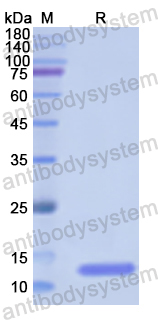Catalog No.
YHF07201
Expression system
E. coli
Species
Homo sapiens (Human)
Protein length
Met1-Leu103
Predicted molecular weight
13.50 kDa
Nature
Recombinant
Endotoxin level
Please contact with the lab for this information.
Purity
>90% as determined by SDS-PAGE.
Accession
P55000
Applications
ELISA, Immunogen, SDS-PAGE, WB, Bioactivity testing in progress
Form
Lyophilized
Storage buffer
Lyophilized from a solution in PBS pH 7.4, 0.02% NLS, 1mM EDTA, 4% Trehalose, 1% Mannitol.
Reconstitution
Reconstitute in sterile water for a stock solution. A copy of datasheet will be provided with the products, please refer to it for details.
Shipping
In general, proteins are provided as lyophilized powder/frozen liquid. They are shipped out with dry ice/blue ice unless customers require otherwise.
Stability and Storage
Use a manual defrost freezer and avoid repeated freeze thaw cycles. Store at 2 to 8°C for frequent use. Store at -20 to -80°C for twelve months from the date of receipt.
Alternative Names
ARS(component B)-81/S, SLURP-1, ARS component B, Anti-neoplastic urinary protein, Secreted Ly-6/uPAR-related protein 1, SLURP1, ANUP, ARS
Integrating analysis of multi-omics summary data identifies novel plasma protein biomarkers and drug targets for bladder cancer., PMID:40316856
Combination with a Low Dose of Doxorubicin Further Boosts the Antitumor Effect of SLURP-1 In Vivo and Associates with EGFR Down-Regulation., PMID:40264586
Potential therapeutic targets for bladder cancer: a proteome-wide Mendelian randomization study., PMID:40226474
The Secreted Ly6/uPAR-Related Protein-1 (SLURP1) Protects the Cornea From Oxidative Stress., PMID:40094657
A signal peptide variant in SLURP1 with dominant-negative effect causes progressive symmetric erythrokeratodermia., PMID:40023748
Autosomal dominant SLURP1 variants cause palmoplantar keratoderma and progressive symmetric erythrokeratoderma., PMID:39913669
Targeting MAPK14 by Lobeline Upregulates Slurp1-Mediated Inhibition of Alternative Activation of TAM and Retards Colorectal Cancer Growth., PMID:39840525
Proteome-wide Mendelian randomization and therapeutic targets for bladder cancer., PMID:39707285
Water-Soluble Lynx1 Upregulates Dendritic Spine Density and Stimulates Astrocytic Network and Signaling., PMID:39565568
Application of large-scale and multicohort plasma proteomics data to discover novel causal proteins in gastric cancer., PMID:39422802
Stress Affects Mast Cell Proteases in Murine Skin in a Model of Atopic Dermatitis-like Allergic Inflammation., PMID:38891925
Pain Hypersensitivity in SLURP1 and SLURP2 Knock-out Mouse Models of Hereditary Palmoplantar Keratoderma., PMID:38866482
Unveiling the potential of SLURP1 protein as a biomarker for prostate cancer screening., PMID:38686195
A novel mutation in SLURP1 in patients with Mal de Meleda from Turkey., PMID:38647179
Scalable production of recombinant three-finger proteins: from inclusion bodies to high quality molecular probes., PMID:38347541
Single-cell transcriptome analysis reveals keratinocyte subpopulations contributing to psoriasis in corneum and granular layer., PMID:38279596
The Secreted Ly6/uPAR-Related Protein 1 (Slurp1) Modulates Corneal Angiogenic Inflammation Via NF-κB Signaling., PMID:38252525
Comparison of Conformations and Interactions with Nicotinic Acetylcholine Receptors for E. coli-Produced and Synthetic Three-Finger Protein SLURP-1., PMID:38069271
Inflammation-Related Immune-Modulatory SLURP1 Prevents the Proliferation of Human Colon Cancer Cells, and Its Delivery by Salmonella Demonstrates Cross-Species Efficacy against Murine Colon Cancer., PMID:37896222
Selective targeting of α7 nicotinic acetylcholine receptor by synthetic peptide mimicking loop I of human SLURP-1 provides efficient and prolonged therapy of epidermoid carcinoma in vivo., PMID:37854069
Accumulation of β-Amyloid Leads to a Decrease in Lynx1 and Lypd6B Expression in the Hippocampus and Increased Expression of Proinflammatory Cytokines in the Hippocampus and Blood Serum., PMID:37833597
Molecular Characterization of Esophageal Squamous Cell Carcinoma Using Quantitative Proteomics., PMID:37444412
Identification of a novel compound heterozygous mutation and a homozygous mutation of SLURP1 in Chinese families with Mal de Meleda., PMID:37393290
Seven Immune-Related Genes' Prognostic Value and Correlation with Treatment Outcome in Head and Neck Squamous Cell Carcinoma., PMID:39282247
Frizzled receptors and SFRP5 in lipid metabolism: Current findings and potential applications., PMID:36631199
Secreted Ly-6/uPAR-related protein-1 (SLURP1) is a pro-differentiation factor that stalls G1-S transition during corneal epithelial cell cycle progression., PMID:34923162
Endogenous α7 nAChR Agonist SLURP1 Facilitates Escherichia coli K1 Crossing the Blood-Brain Barrier., PMID:34721415
SLURP-1 Controls Growth and Migration of Lung Adenocarcinoma Cells, Forming a Complex With α7-nAChR and PDGFR/EGFR Heterodimer., PMID:34595181
Regulation of Immune Functions by Non-Neuronal Acetylcholine (ACh) via Muscarinic and Nicotinic ACh Receptors., PMID:34202925
Clinical characteristics of four myositis-specific autoantibodies with regulatory-approved testing in Japan: A Japanese multi-centre adult myositis patients' cohort., PMID:34088590
Texture analysis of muscle MRI: machine learning-based classifications in idiopathic inflammatory myopathies., PMID:33972636
Hereditary palmoplantar keratoderma - phenotypes and mutations in 64 patients., PMID:33914963
New Pathways for the Skin's Stress Response: The Cholinergic Neuropeptide SLURP-1 Can Activate Mast Cells and Alter Cytokine Production in Mice., PMID:33815383
Biochemical Basis of Skin Disease Mal de Meleda: SLURP-1 Mutants Differently Affect Keratinocyte Proliferation and Apoptosis., PMID:33741389
Comparison of Lesional Juvenile Myositis and Lupus Skin Reveals Overlapping Yet Unique Disease Pathophysiology., PMID:33305541
Structural Diversity and Dynamics of Human Three-Finger Proteins Acting on Nicotinic Acetylcholine Receptors., PMID:33019770
Recombinant Analogue of the Human Protein SLURP-1 Inhibits the Growth of U251 MG and A172 Glioma Cells., PMID:32894468
Efficient screening of ligand-receptor complex formation using fluorescence labeling and size-exclusion chromatography., PMID:32828540
Three-finger proteins from snakes and humans acting on nicotinic receptors: Old and new., PMID:32648941
Abnormal keratinization and cutaneous inflammation in Mal de Meleda., PMID:32157724
Recombinant Analogue of the Human Protein SLURP-1 Inhibits the Growth of Multicellular Spheroids Reconstructed from Carcinoma Cells., PMID:32130608
Human secreted protein SLURP-1 abolishes nicotine-induced proliferation, PTEN down-regulation and α7-nAChR expression up-regulation in lung cancer cells., PMID:32106059
Mal de Meleda with homozygous mutation p.G86R in SLURP-1., PMID:32048728
S-adenosylhomocysteine (AdoHcy)-dependent methyltransferase inhibitor DZNep overcomes breast cancer tamoxifen resistance via induction of NSD2 degradation and suppression of NSD2-driven redox homeostasis., PMID:32001260
Phenotypic Variability with SLURP1 Mutations and Diffuse Palmoplantar Keratoderma., PMID:31944258
In-silico Analyses of Disease Causing Mutations in SLURP1 Gene., PMID:31882421
Genome-wide association for milk production and lactation curve parameters in Holstein dairy cows., PMID:31576624
A Case of Malignant Melanoma Arising in Nagashima-type Palmoplantar Keratosis., PMID:31573665
Cholinergic signalling mechanisms and early implant healing phases in healthy versus generalized aggressive periodontitis patients: A prospective, case-control study., PMID:31444906
Novel nonsense variants in SLURP1 and DSG1 cause palmoplantar keratoderma in Pakistani families., PMID:31443639

